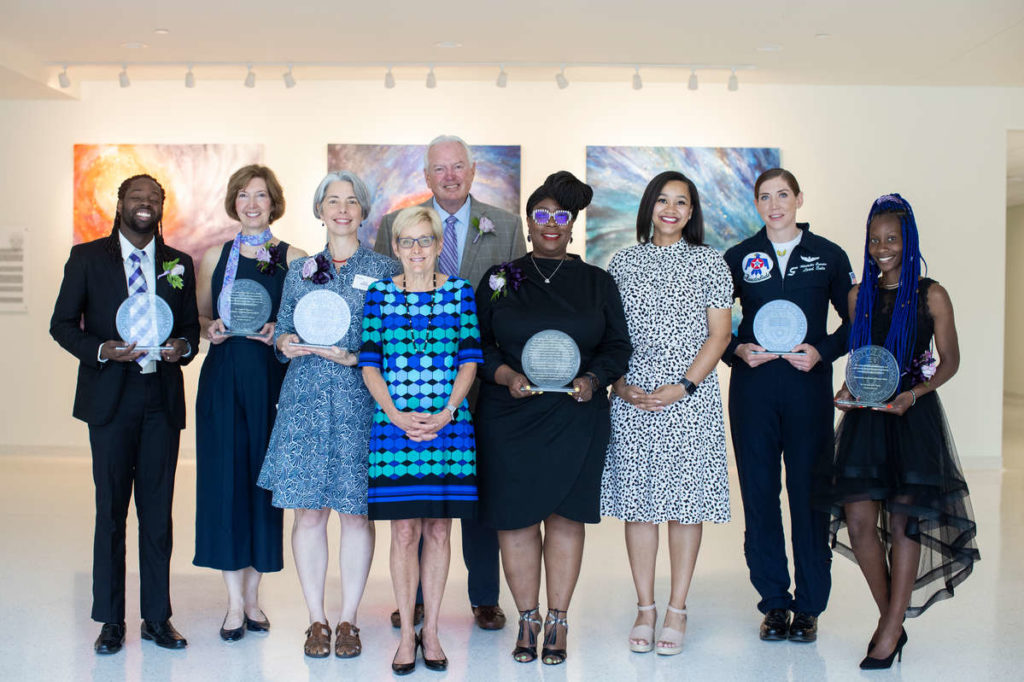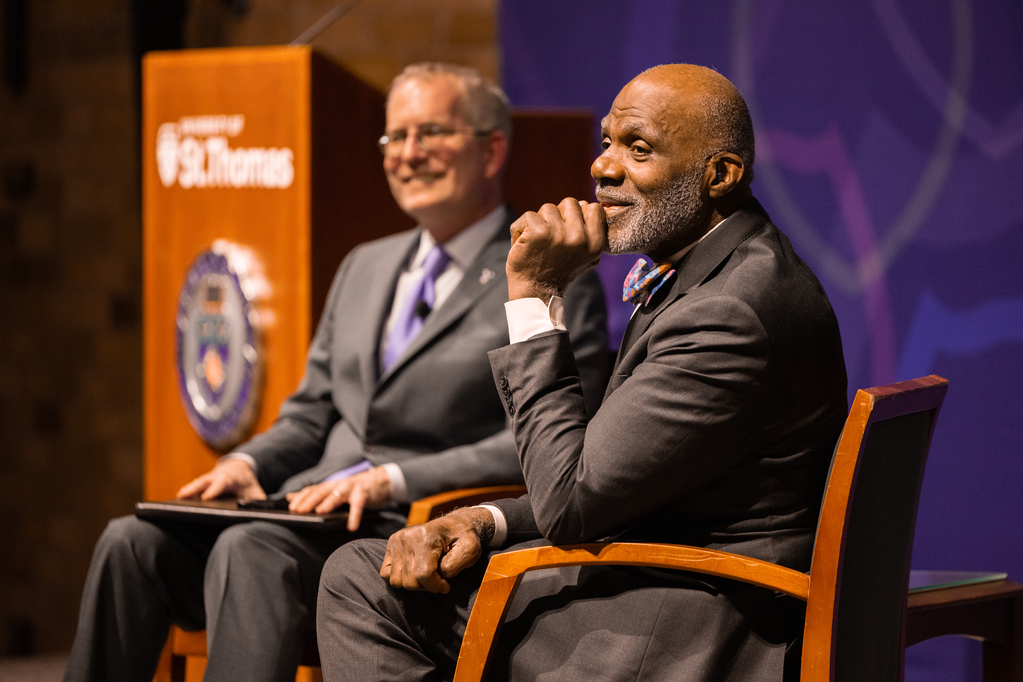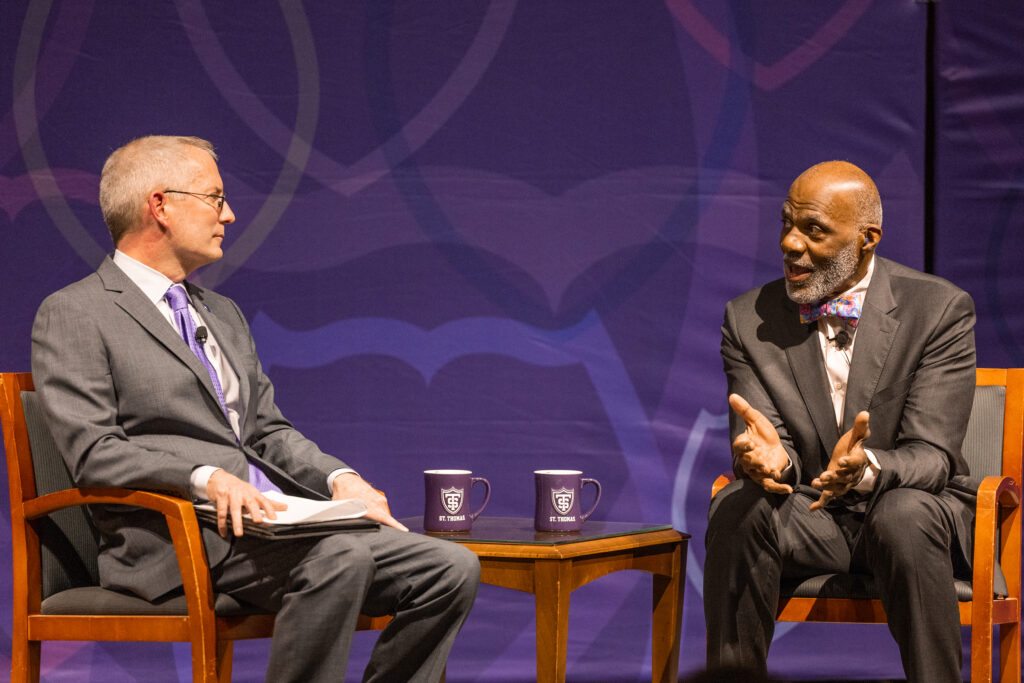The St. Thomas 2025 strategic plan provides a map to our future as a university.
When talking about St. Thomas 2025, the university’s new strategic plan, people use the word “bold." Bold means confident and courageous. It means showing an ability to take risks. It also perfectly describes St. Thomas’ 10-year aspiration to rise to a level of excellence that distinguishes the nation’s top 10 Catholic universities.
With its ambitious strategic plan filled with six themes and 16 priorities that touch every part of the university, St. Thomas is ready to raise its national visibility.
“We are at an inflection point,” President Julie Sullivan said, “and what we do in the next three to five years will determine the trajectory of our journey for many decades to come.”
The university was off to a running start with its last strategic plan in 2015; it guided impressive outcomes, including the launch of the Dougherty Family College, Morrison Family College of Health, Center for Well-Being, Iversen Center for Faith and nearly $100 million in philanthropic gifts for scholarships.
President Sullivan was candid when answering questions about St. Thomas 2025:

Why is it important for St. Thomas to be considered a top 10 Catholic university?
When we say we aspire to achieve the level of excellence, impact and reputation that distinguishes the top 10 national Catholic universities, the most important words in that sentence are “level of excellence, impact and reputation that distinguish.” We're not trying to be Notre Dame or Georgetown or any other university currently in the top 10.* We're not even trying to chase a ranking. But as we endeavor to achieve a reputation, we know we can have an impact bolder and broader than what we’ve achieved today.
We want to achieve this in our own unique way, playing to our strengths, identity, history, traditions and dreams – who we are.
An increased level of excellence and a focus on addressing the world’s great challenges will lead us.
What distinguishes the top 10 national Catholic universities when it comes to student outcomes?
If you look at them as a group, they differ from us in a few ways. They tend to have somewhat higher retention and graduation rates than we do. That’s something we are extremely focused on and have improved over the last five years. We want to continue making improvements.
They tend to devote more resources to supporting their students. Many of them meet a higher percentage of financial need for their incoming students than we do. We have improved on this greatly over the last five years, and our highest fundraising priority today is raising more funds for scholarships to support students.
And then there’s visibility, which helps increase national awareness. If a high school student walks into a guidance counselor's office in Washington, D.C., and says “I’m interested in going to school in the Upper Midwest” or “I’m interested in going to a Catholic university and I want to study engineering,” or “I want to study business,” or “I want to be an English major,” we want that counselor to put us in that group of schools that should be explored.
How will the university look or act differently in the next decade when it comes to faculty expertise as we work to achieve this aspiration?
We have great faculty expertise and need to nurture and promote it. The top 10 schools have distinct areas of expertise that they're known for. We are developing more areas that distinguish us and promoting that expertise, and we'll continue doing that.
How do we know we've arrived? It means when important conversations are happening, we’ll be at the table. Are our faculty being asked to talk about climate change, or trauma-informed education, or pedagogy of confidence, or the ethical considerations of artificial intelligence, or historical recovery and racial reconciliation? When people talk about the critical issues of our day, whether it's academics or broad community concerns – are we invited to these conversations? Do we have a meaningful voice?

How is the Catholic mission of St. Thomas manifested in this plan?
We have a strong foundation – our Catholic faith and mission is our foundation.
Our Catholic mission is central to our whole-person education. If we're really concerned about developing the whole person, faith and spirituality are very important. Whether our students are Catholic or profess other beliefs, we have to be dedicated to developing, guiding and affirming their spiritual journeys. It's a part of our liberal arts heart. Catholic intellectual tradition calls us to prepare people who are broadly educated and who have had interdisciplinary education and experiences, people who understand how things fit together and see the whole picture of faith and reason.
Catholic social teaching is what gives us that responsibility and determination to play a leadership role in meeting society's needs. Motivated by our Catholic faith, we are called to advance the common good, to make this a community where everyone has their full human dignity and can actualize their full potential without inequities, without barriers. It’s why our School of Education and our Dougherty Family College are focused on eliminating education, workforce and prosperity gaps that exist. It’s why we are building the Morrison Family College of Health to address inequities in health care and improve health care systems.
What place does diversity, equity and inclusion work have in the 2025 strategic plan?
The question is, where are diversity, equity and inclusion not in the plan? There are important aspects of DEI work embedded in all of the plan’s priorities.
Our plan calls us to foster belonging and dismantle racism at St. Thomas and within our broader community. We also are prioritizing preparing educators to dismantle disparities in the classroom and tackling inequities through the Dougherty Family College. But other priorities emphasize inclusivity as well, like leading in STEAM (science, technology, engineering, arts and math) education. When we say leading in STEAM education, we mean we want to create the diverse and broad-minded STEAM leaders of tomorrow. Through the guiding principles and the design of our STEAM complex – inclusive, innovative, collaborative, connected, adaptable and sustainable – we are planning an education facility that will very intentionally attract students who will bring diverse perspectives to their work. As we talk with corporate partners – particularly those looking to employ a more diverse STEAM workforce – we know we can attract tomorrow’s leaders and prepare them for the workforce.
What role do athletics and our new D-I status play in this aspiration?
It’s no secret that the move to Division I is a big step for St. Thomas. Our athletes will compete at a more competitive level; our games will receive more attention, whether it's from fans, the community or the media. We will play a number of schools that are more dispersed geographically. We’ll develop new rivalries, attract new fans and play on a bigger stage.
Athletics also builds school spirit, which helps get students engaged on campus and keeps them engaged as alumni. It’s already helping us to draw a more geographically diverse student body. Our first class of about 150 incoming athletes this fall come from 16 states and three countries outside the United States. Importantly, they also have excellent academic potential with an average GPA of 3.65.
With six new and emerging priorities and 10 ongoing priorities, in what tangible ways will you measure success?
We will intentionally measure our progress on key factors related to each priority and embed this plan in our existing and ongoing work. Importantly, the plan is integrated into our current organization structure and allows our entire community to be engaged. We're not creating new committees and new groups to make this happen, it's a part of our everyday work. The possibilities are powerful in a motivated and focused organization of nearly 10,000 students and 2,000 employees.
How will St. Thomas fund such a bold plan?
Some priorities will be funded through internal prioritization, by focusing resources where we can have the most success. We also will seek new revenue sources from innovative programs and opportunities. And we will increase our fundraising efforts. The Board of Trustees recently approved a comprehensive 10-year capital campaign that will attract donors who want to help us achieve these goals because of the impact we can have on society. Donors will help us keep St. Thomas affordable, enrich the student experience, raise our national profile and achieve our 10-year aspiration.
What do you say to people who think St. Thomas is changing too fast?
I’d say that adaptation and moving forward are part of the lifeblood of this university. Monsignor Terrence Murphy, two presidents before me, said, “If you're not moving forward, you're going backwards.” That is so true, especially today. The entire world is changing, and for some people, it’s too fast and too much. But we don't have a choice but to be a part of it. It means we have to be intentional, so we retain the things that have made us who we are, while we meet new challenges in a rapidly changing world.
* Top 10 national Catholic universities according to 2021 U.S. News & World Report: University of Notre Dame, Georgetown University, Boston College, Villanova University, Santa Clara University, Loyola Marymount University, Fordham University, Gonzaga University, University of San Diego and Marquette University. St. Thomas is tied for 17th in the rankings.







